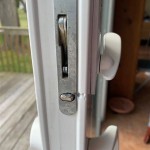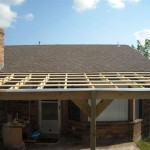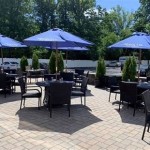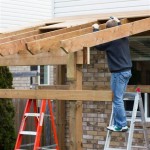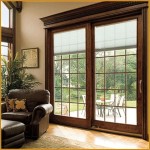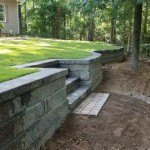Creating an Inviting Outdoor Patio with a Fire Pit
An outdoor patio with a fire pit is a highly desirable feature for many homeowners. It transforms a simple outdoor space into a versatile area for relaxation, entertainment, and even cooking. The flickering flames and radiating warmth create an ambiance that encourages gathering and extends the usability of the patio well into the cooler months. Careful planning and thoughtful design are crucial to maximizing the functionality and aesthetic appeal of such a space.
Several key considerations must be addressed when planning an outdoor patio with a fire pit. These include the size and layout of the patio, the type of fire pit selected, the materials used for the patio and surrounding features, and adherence to local regulations and safety precautions. Neglecting these aspects can lead to an unsatisfactory result that is both aesthetically unpleasing and potentially unsafe.
Choosing the Right Fire Pit
The selection of a fire pit is paramount to the overall design and functionality of the patio. Fire pits vary significantly in terms of fuel source, size, style, and material. Understanding these variations is essential for making an informed decision that aligns with individual needs and preferences.
Fuel source is a primary consideration. Common options include wood-burning, propane, and natural gas fire pits. Wood-burning fire pits offer the classic crackling sound and aroma that many find appealing. However, they also require a readily available wood supply and adherence to local regulations regarding open burning. They also produce smoke and require more maintenance due to ash removal.
Propane fire pits offer convenience and cleanliness. They are easily lit and extinguished, and they produce little to no smoke. However, they require a propane tank, which needs to be stored and refilled. These fire pits sometimes sacrifice the authentic aesthetic of wood burning.
Natural gas fire pits offer the ultimate convenience if a natural gas line is available. They provide a consistent fuel supply and eliminate the need for tank refills or wood gathering. However, the initial installation requires professional plumbing and is generally more expensive.
The size of the fire pit should be proportional to the size of the patio. A fire pit that is too large can overwhelm a small patio, while one that is too small may not provide sufficient warmth or visual impact on a larger patio. Consider the number of people who will typically be using the patio and choose a fire pit that can comfortably accommodate them.
Style and material are also important considerations. Fire pits are available in a wide range of styles, from rustic and traditional to modern and contemporary. Materials include concrete, stone, brick, metal, and tile. The chosen style and material should complement the overall design of the patio and the surrounding landscape.
Patio Design and Material Selection
The design and layout of the patio itself are crucial to creating a functional and aesthetically pleasing space surrounding the fire pit. The patio should be large enough to accommodate seating, a fire pit, and ample circulation space. Consider the flow of traffic and ensure that there is enough room for people to move around comfortably, even when the fire pit is in use.
The choice of patio materials is a significant factor in both the appearance and durability of the space. Common patio materials include concrete, pavers, stone, brick, and composite decking. Each material has its own advantages and disadvantages in terms of cost, maintenance, durability, and aesthetic appeal.
Concrete is a versatile and affordable option. It can be poured in various shapes and sizes and can be stained or stamped to create a variety of textures and patterns. However, concrete can crack over time, especially in areas with extreme temperature fluctuations.
Pavers are a popular choice for patios. They are available in a wide range of colors, shapes, and sizes, and they are relatively easy to install. Pavers are also durable and resistant to cracking. However, they can be more expensive than concrete, and they require regular maintenance to prevent weed growth between the pavers.
Stone is a natural and aesthetically pleasing option. It is durable and long-lasting, and it can add a touch of elegance to any outdoor space. However, stone can be expensive and difficult to install. Irregularly shaped stones can also present tripping hazards.
Brick is a classic and timeless choice for patios. It is durable and relatively low-maintenance. Brick can also be laid in various patterns to create unique designs. However, brick can be susceptible to cracking and fading over time.
Composite decking is a low-maintenance alternative to wood decking. It is made from recycled plastic and wood fibers, and it is resistant to rot, insects, and fading. Composite decking is also relatively easy to install. However, it can be more expensive than wood decking, and it can become hot in direct sunlight.
In addition to the patio surface itself, consider the surrounding landscaping and features. Walls, fences, and hedges can provide privacy and shelter from the wind. Plants and flowers can add color and texture to the space. Lighting can enhance the ambiance and extend the usability of the patio into the evening hours.
Safety Regulations and Best Practices
Safety is a paramount concern when designing and using an outdoor patio with a fire pit. Adherence to local regulations and the implementation of best practices are essential for preventing accidents and ensuring the well-being of everyone using the space.
Local regulations regarding fire pits vary widely. Some municipalities may require permits for the installation of fire pits, while others may have restrictions on the type of fuel that can be used or the distance that the fire pit must be from structures and property lines. Before installing a fire pit, it is crucial to check with the local building department to ensure compliance with all applicable regulations.
Beyond local regulations, several best practices should be followed to ensure the safe operation of a fire pit. These include maintaining a safe distance between the fire pit and any combustible materials, such as trees, shrubs, and buildings; never leaving a fire unattended; keeping a fire extinguisher or garden hose nearby; and ensuring that the fire is completely extinguished before leaving the area.
It is also important to educate all users of the fire pit about proper safety procedures. Children should be supervised at all times when the fire pit is in use, and everyone should be aware of the potential hazards associated with open flames. Providing clear and concise safety instructions can help prevent accidents and ensure that everyone can enjoy the patio safely.
Furthermore, consider the placement of seating around the fire pit. Ensure that seating is far enough away from the flames to prevent accidental burns, but close enough to allow for comfortable conversation. Using fire-resistant materials for seating cushions and covers can also help to minimize the risk of fire damage.
Regular maintenance is essential for ensuring the safe and efficient operation of a fire pit. Wood-burning fire pits should be cleaned regularly to remove ash and debris. Propane and natural gas fire pits should be inspected periodically for leaks and other damage. Addressing any problems promptly can help prevent accidents and extend the lifespan of the fire pit.
Proper ventilation is also important, especially when using a fire pit in an enclosed space. Ensure that there is adequate airflow to prevent the buildup of carbon monoxide, a colorless and odorless gas that can be deadly. Never use a fire pit indoors or in a partially enclosed space without adequate ventilation.
By carefully considering these key points and adhering to local regulations and best practices, homeowners can create an inviting and safe outdoor patio with a fire pit that will provide years of enjoyment.

30 Fire Pit Ideas That Are Under The Budget Backyard Patio

60 Backyard And Patio Fire Pit Ideas Diffe Types With Photo Examples Landscaping Outdoor Designs

Should I Install An Outdoor Fireplace Or Firepit Jt Landscaping

Patio Fire Pit And Seating Wall Combinations Construction In Muskegon Mi

Where To Build A Fire Pit On The Patio Or Separate Area Of Our Landscape Design

Outdoor Fire Pits Northern Virginia Fireplaces Home Living

12 Best Outdoor Fire Pit Ideas Diy Backyard

Fire Pit Installation J Landscape Management

Best Fire Pit Ideas Heated Backyard Retreat Designs Natural Brick Stone Depot

Fire Pit Ideas And Inspiration Forbes Home
Related Posts

